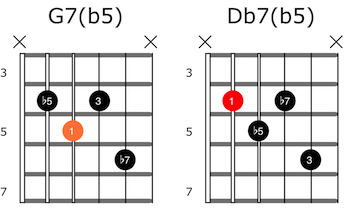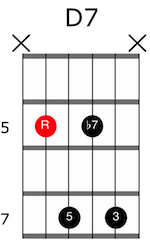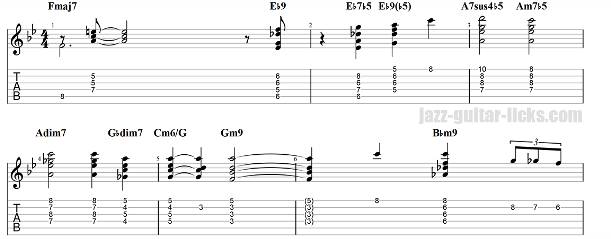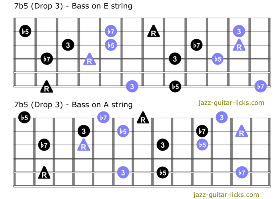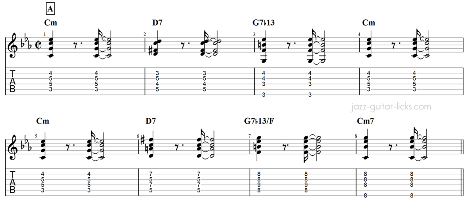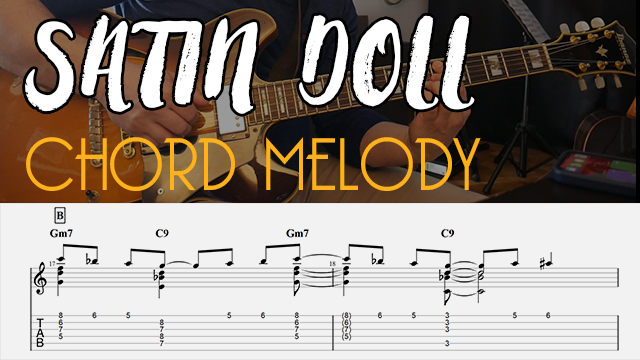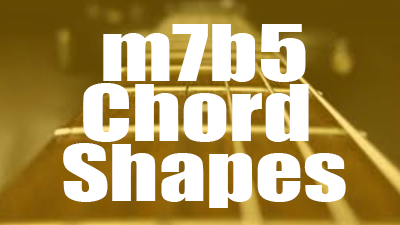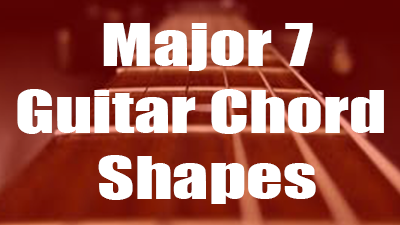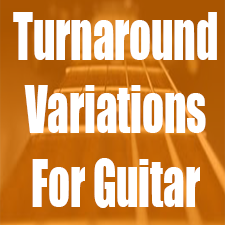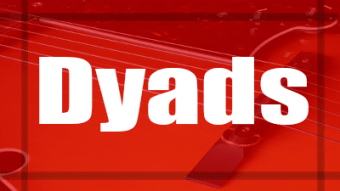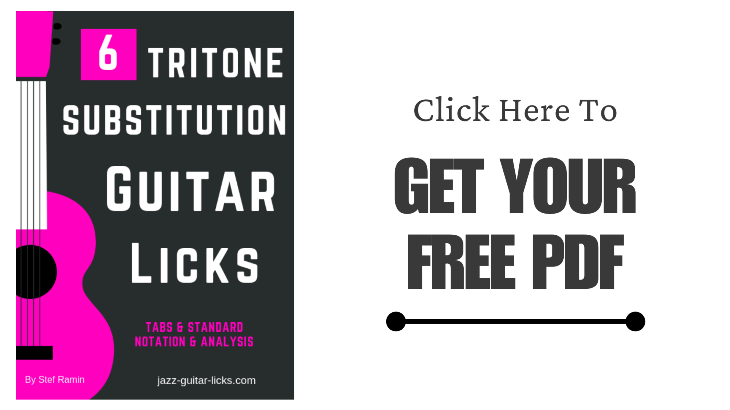harmony
-
Slash Chords On Guitar - Lesson With Charts And Diagrams
- By jazz-guitar-licks
- On 2024-03-07
- In Jazz Guitar Lessons
- 0 comments
Slash chords, distinguished by a chord followed by a forward slash and a bass note (e.g., C/G), are a powerful tool for enriching your guitar sound.
This guitar lesson for beginners unravels the mystery behind slash chords, revealing how they redefine familiar shapes and add a touch of sophistication to your chord progressions.
-
Chord Substitution - Enharmonic Equivalents - Altered & Extended Dominant Seventh Chords
- By jazz-guitar-licks
- On 2023-12-19
- 0 comments
This guitar theory lesson about harmonic equivalents provides six examples, that demonstrate how dominant seventh chords (rootless, altered or extended) can also be considered as other types of chords (min6, dim7, 7).
-
How To Identify Chords By Ear - Advices And Practice Tips For Guitar Players
- By jazz-guitar-licks
- On 2023-09-09
- In Guitar Practice Tips
- 0 comments
Identifying chords by ear is a valuable skill for any musician, especially in jazz. Here's a step-by-step guide to help you develop your ability to identify chords by ear:
-
Harmonization of Minor Scales On Guitar - Natural, Melodic and Harmonic Minor
- By jazz-guitar-licks
- On 2023-08-03
- 4 comments
Harmonization of minor scales involves creating chords by stacking thirds on each note of the scale.
There are three common types of minor scales: natural minor, melodic minor, and harmonic minor.
This guitar lesson explore each one and explain how to harmonize them on guitar.
-
Dominant, Subdominant, Secondary Subdominant and Secondary Dominant Chords - Guitar Theory Lesson
- By jazz-guitar-licks
- On 2023-07-30
- 0 comments
In music theory, the terms "dominant," "subdominant," and "secondary dominant" are used to describe different types of chords and their functions within a key or harmonic progression.
Here's an explanation of each term with examples for guitar players.
-
Chord Extensions - Music Theory Lesson
- By jazz-guitar-licks
- On 2022-06-07
- 0 comments
In this theory lesson we will see how to add natural and altered extensions to 7th chords. The aim being to bring new colors and so to embellish your chord progressions. This concept is a very important device for composing, chordal accompaniment and chord-melody arrangements.
-
Days of Wine And Roses - Guitar Chord Melody Lesson With Tab
- By jazz-guitar-licks
- On 2021-10-19
- 0 comments
This lesson provides a chord melody arrangement for guitar of the famous song "Days of Wine and Roses" written by Henry Mancini (music) and Johnny Mercer (lyrics) for the movie film of the same name.
-
How to Use 7b5 Chords? Guitar Lesson With Shapes and Tabs
- By jazz-guitar-licks
- On 2021-10-12
- 0 comments
Altered chords are a very important part of jazz language, they are built by altering with a flat or a sharp one or more notes of a diatonic chord. They are very useful to bring a little bit of tension to any jazz chord progression.
This lesson focusses on dominant seventh flat fifth chords (7b5), that are dominant seventh chords with a lowered fifth, given the formula : root (R), third (3), flat fifth (b5) and minor seventh (b7).
-
Armando's Rumba - Guitar Chords
- By jazz-guitar-licks
- On 2021-07-07
- 0 comments
This lesson provides a chord study with tab of the Latin jazz tune Armando's rumba by Chick Corea based on the Latin Real Book version in C minor. Here below you'll find guitar tabs corresponding to the four main parts of the tune (A-B-C-D).
The chords used in this arrangement are mostly seventh chords as min7, maj7, dim7 and dom7 (drop 2, drop 3 and rootless voicings) including basic triads (min, aug) and altered dominant chords (7#9, 7b13).
-
Satin Doll Arranged For Jazz Guitar - Video With Tabs
- By jazz-guitar-licks
- On 2021-03-15
- 0 comments
Check out the latest video from the YouTube channel. This is a chord melody arrangement for guitar of Duke Ellington's jazz standard "Satin Doll".
This free lesson with tabs is intended for intermediate players who want to practice some drop 2, drop 3 voicings, walking bass lines, chords inversions and substitutions over one of the most popular jazz tune.
-
Half-diminished Chords - 28 Guitar Shapes
- By jazz-guitar-licks
- On 2020-09-18
- In Chords / Voicings
- 0 comments
Half-diminished chords (aka m7b5) have an especially important place in jazz music. They are generally found in minor 2 5 1 progressions as the ii chord or can be used as substitutions for dominant 7 chords. This blog post provides 28 different shapes based on drop 2, drop 3 and drop 2-4 voicings for playing m7b5 chords on guitar.
-
28 Major 7 Guitar Chord Diagrams
- By jazz-guitar-licks
- On 2020-08-28
- In Chords / Voicings
- 0 comments
This blog post provides 28 positions with intervals to play major seventh chords (maj7) on guitar. Three types of voicings are used : drop 2, drop 3, drop 2-4 and their inversions.
The diagrams are organized this way:
-
Cluster Chords On Guitar - Theory And Exercises With Tabs
- By jazz-guitar-licks
- On 2020-08-19
- 2 comments
This guitar lesson with tabs and theory is about cluster chord voicings.
These are chords in which at least two notes are grouped together in order to create a sort of dissonance.
Cluster chords are sometimes quite difficult to play on guitar but they have a very interesting sound widely used in comtemporary jazz and neo-soul music.
-
1 6 2 5 Turnaround Variations - Lesson With Guitar Tabs & Theory
- By jazz-guitar-licks
- On 2020-04-17
- In Jazz Guitar Lessons
- 2 comments
A turnaround is a section of two or four bars at the end of a tune.
Its role is to create a harmonic transition going back to the beginning.
It present in many jazz tunes and is an important part of "rhythm changes" progressions.
They is also used to create effective jazz intros and endings.
This lesson with guitar tabs contains 17 exercises for better understanding of the 1 6 2 5 turnaround and its variations.
-
Diatonic Dyads For Guitar - Lesson With Shapes - Music Theory
- By jazz-guitar-licks
- On 2019-09-29
- In Jazz Guitar Lessons
- 0 comments
In music, a dyad refers to a two-note chord or interval. Unlike traditional chords, which consist of three or more notes played simultaneously, dyads are comprised of only two notes. This guitar lesson explores the concept of diatonic dyads.
-
36 Ways of Playing a Dominant 7 Chord on Guitar
- By jazz-guitar-licks
- On 2019-07-30
- 0 comments
Dominant 7 chords are one of the most important chords to know, they can be found in many styles of music as blues, funk, pop and of course in jazz music. In this lesson we will see how dominant 7 chords are built and how to play them on guitar using 36 different voicing shapes.

